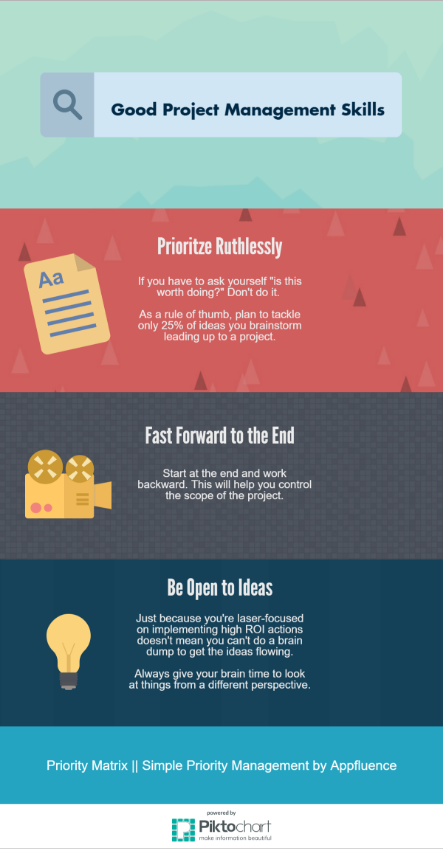What is Project Management?
Definition of Project Management
Project Management is working with a team, or multiple teams in different concentrations in order to plan a project while managing a company’s resources to accomplish all the tasks that constitute a project.
As a result, it is important to accomplish the project on a schedule and to achieve a goal, whether that is to finish a construction assignment, a marketing initiative, or something else.
Effective project management takes a person with good organization and prioritization skills to finish a project successfully.
Importance of Good Project Management Skills
The biggest reasons good project management skills are important for us include:
- We have limited resources, for example, limited time, employees, capital, etc.
- We have so many things to do, and not enough time to work on everything that we would like to.
- Not everything that we do will have a positive return of investment, and sometimes, you do not know whether or not the ROI will be high or low until you try.
Given these reasons, we must constantly evaluate and identify good project management techniques to help us achieve projects on time and within our resource constraints.
What is A Project Manager?
A Project Manager is a person who is involved in the “planning, control, and coordination of all aspects of a project in order to achieve the agreed objectives.”
This includes:
- Initiating
- Planning
- Executing
- Controlling
- Closing
Thus a Project Manager’s decisions ultimately determine if the project is a success or a failure.
Project Manager Core Competencies
Core Competencies are the skills that many successful Project Managers must use in order to strive and achieve their goals.
Some of these skills include, but are not limited to:
- Determining which goals need to be achieved, and then carrying out a project that will help execute those goals
- Deciding which smaller tasks need to be completed in order to finish the project in the time allotted
- Being able to think quickly when curveballs are thrown, and remedying those issues by fixing the problem or creating an alternative
Below, is a good list of core competencies in project management, and the abilities needed to be able to carry them out.
Core Competencies Examples

Skills of Successful Project Managers
Qualities of a Project Manager
In order to be a successful project manager, you must not only possess the skills listed under Core Competencies, but you must also exhibit certain attributes to help you attain your goals.
Below are some qualities that are useful to have as a successful project manager:
- Leadership: The ability to take charge and get things done, all while creating a positive working environment where success is possible.
- Motivation: Not only is it important to be able to motivate yourself, but it is also of great importance to motivate your employees to help them achieve more. Many motivated project managers encourage teamwork because it helps to motivate and to create a cohesive team.
- Organization: Successful project managers are able to stay organized by being able to prioritize their competing obligations and working with the end goal in mind.
- Conscientiousness: Continuously planning for the future and making sure that projects are on track, on budget, and on schedule.
- Personable: Emphasizes with employee needs while taking input from their team when making decisions, encouraging comments and concerns.
What are Project Management Skills?
Project Management Skills are abilities that are necessary to have when working on projects. Having good project management skills will help to bring value through every step of your project.
Below is a list of project management skills that any good project manager should have, but are also effective for anybody who manages projects in general.
1. Ruthless Prioritization
It is so important to have good prioritization skills because it makes no sense to focus on tasks or projects when your efforts will not be worth it in the end. Thus, you must figure out how to determine where your energy should be focused to make the best out of your limited time and resources, and take you one step closer to achieving your goals.
One way that you can take control of your prioritization is by using the MoSCoW Method. The MoSCoW method helps you figure out which of the tasks in your projects take priority.
The acronym stands for whether the task MUST be completed as the project will not be successful without this component, SHOULD be completed, but will not necessarily contribute to success, COULD be completed if there is enough time, or WON’T be completed, but will try to be if there is time in the future.
Another prioritization technique is the Eisenhower Matrix, created by the 34th President of the United States to determine which of his priorities were critical, and necessary to get to done, as well as which of his priorities were urgent and time sensitive.
As a result, he divided his tasks into quadrants:
- Critical and Urgent
- Critical, but Not Urgent
- Not Critical, but Urgent
- Neither Critical, Nor Urgent
From there, he would spend a majority of his time in that first quadrant, focusing on those crucial and pressing priorities, before moving onto the following quadrants. This helped him get more done.
2. Being Open To Ideas
When you are in control, you have the option to be open to ideas you might have never considered before.
Thus, it is important to take the time to brainstorm a variety of ideas for solving each of your individual tasks. During this process, start by writing them down instead of dismissing them outright. This helps you identify high-variance solutions to some of your toughest problems.
With this being said, do not get overwhelmed; just because you took the time to capture all of your ideas does not mean you should execute all the ideas.
3. The Ability To Fast forward to the end
Start by setting clear expectations, considering your goals that are to be accomplished, and how much of your resources you will use to achieve these goals. This will help you figure out what you hope to have achieved upon project completion.
If you start with the end in mind, you will immediately know what you need to work on and what you don’t need to work on, saving time that could be spent working on other initiatives.
4. When you can’t decide whether something deserves to be done, make the decision to not do it
If you are truly on the borderline about doing something, drop it.
If it becomes important in the future, then it will resurface in a very obvious manner. If that is the case, you can tackle it then, as opposed to wasting your time debating whether it’s worth doing now.
5. Create a concrete plan
When a project begins it is important to outline:
- The project goals and the purpose of the project
- How the project is going to be completed
- The project timeline
- The tasks and subtasks that need to be completed
- Who is involved in the project and what is expected of them, along with which tasks are delegated to whom
This way everybody on your team is at a consensus and understands the importance of their roles. Also, since everything is documented, this holds everybody accountable.
You can even use a tool like Priority Matrix to keep everything even more organized and manage employee performance all around.
6. Identify Project Risks from the start
In the Project Management field, it is very rare to appreciate surprises. Thus, it is good to make a list of all of everything that can go wrong from the start.
Keeping that in mind, however, solely identifying your risks is not enough. You must consider how to manage your risks as well. Yes, it seems like the pessimistic route, but sometimes it is better to expect the worst so you can prevent, or at least minimize, an issue that was preventable in the first place.
Once you consider the risks, make sure that you monitor and continue to evaluate them throughout the project.
7. Seamless Communication
How often has somebody came up to you and explained something to you, but you did not understand exactly what they meant? Perhaps you felt intimidated or did not want to appear like you did not understand, so you decide you will figure it out yourself.
Just because you say something and your team nods their heads does not mean that they have understood what you have said. Or, maybe they think grasped the concept, but they really did not.
Communication is subjective, and there is so much room for errors in the speech communication process. It is possible that the speaker did not communicate their message proficiently, or that the listener was distracted or interpreted the message in a different manner. There could have also been some sort of interference that stopped the listener from getting the message.
Whatever the issue is, it can easily be prevented.
From the start, ensure that everybody understands the meaning that you wished to communicate. Have your team repeat back what you have asked of them so that you can clear up any miscommunications. At this point, establish that you welcome questions so that your employees are not afraid to speak up about any confusion.
Also, keep your team aware of any changes, setbacks, and news so that everybody shares a common ground.
8. Take advantage of Technology
There are so many tools out there that are geared for Project Managers and their teams. In this day and age, putting everything on paper is doable, but not necessarily realistic.
In fact, project management tools help improve the overall flow across teams and organizations as they increase collaboration and organization, allowing teams to track tasks, projects, and initiatives through the tool. As a result, it becomes easier to plan, manage, and execute projects.
In addition, many of these tools offer features such as activity reports and Gantt charts to keep everybody on the right track as well as visually see their progress.
Project Management Tools
Priority Matrix
Priority Matrix is a project management solution that allows you to communicate priorities across your team and provides visibility into shared projects so that you can keep track of the moving parts of your initiatives.
It allows you to monitor all of the tasks in your projects by adding notes, uploading files, setting due dates, communicating through the in-app chat, delegating tasks to team members, and more, all while offering features such as Gantt charts and advanced reports.
Learn more about Priority Matrix for Windows, iPhone, iPad, and Mac.
Try Priority Matrix for Free!
Good Project Management Skills Infographic
Liked the article? Tweet the infographic!

